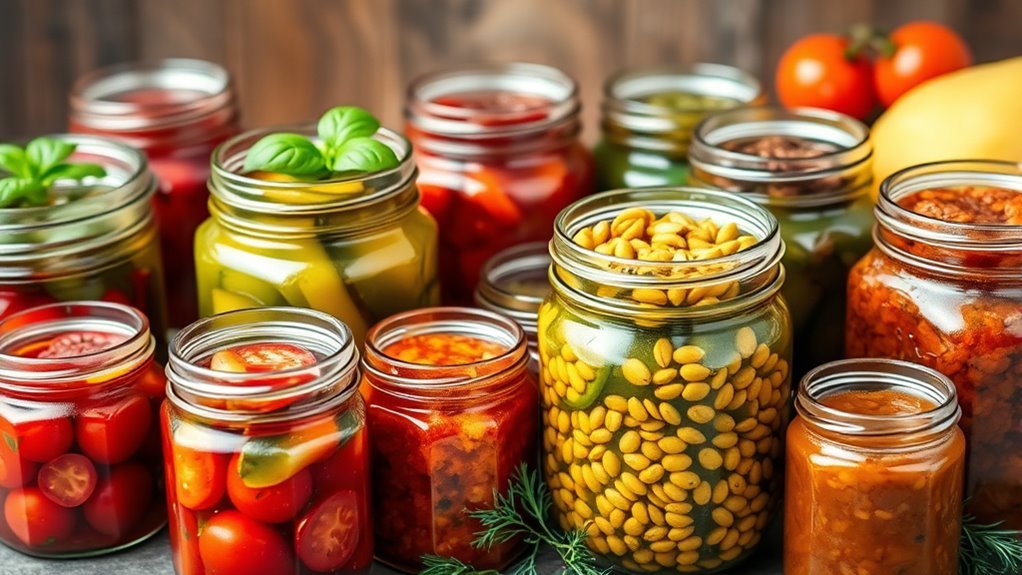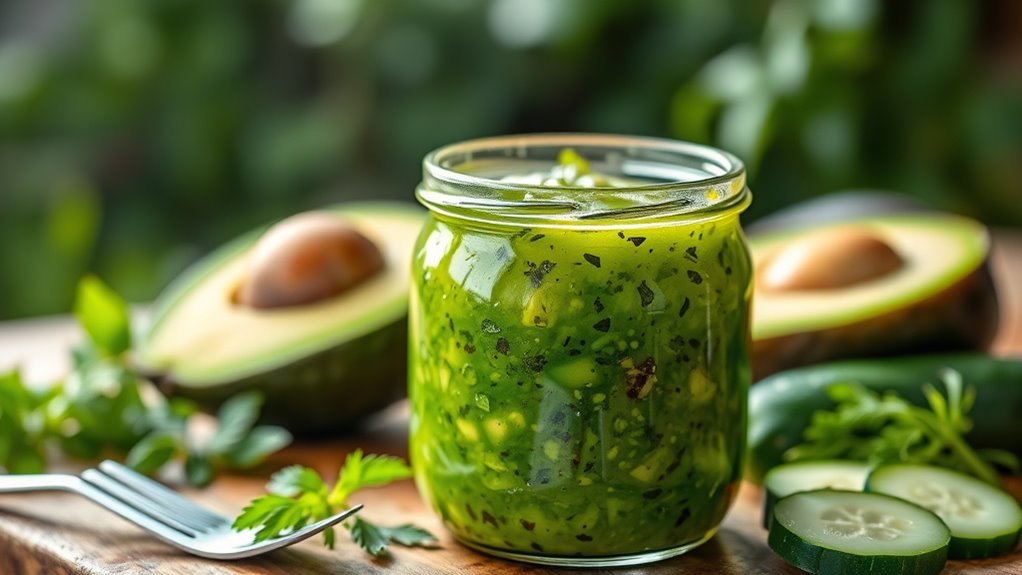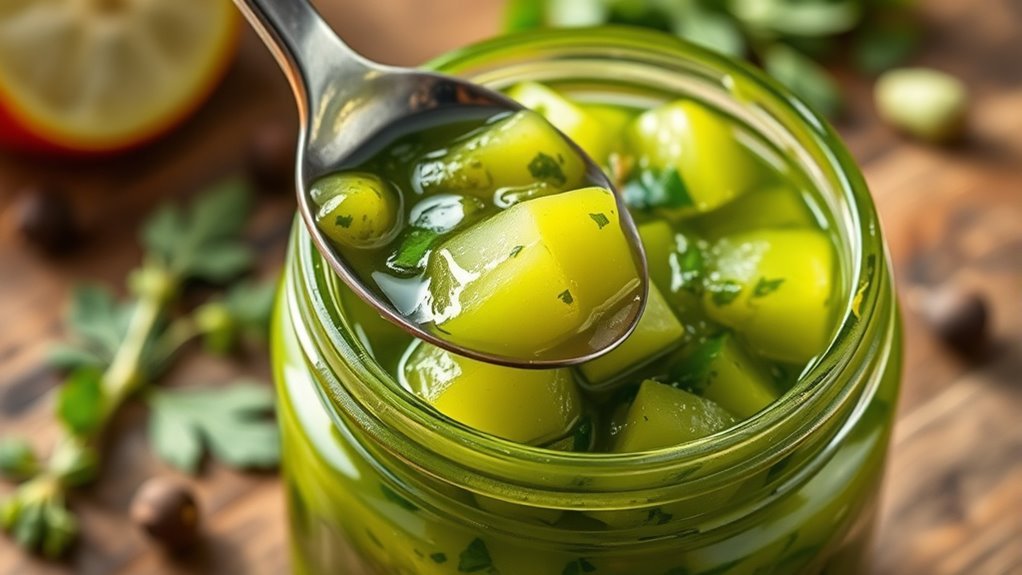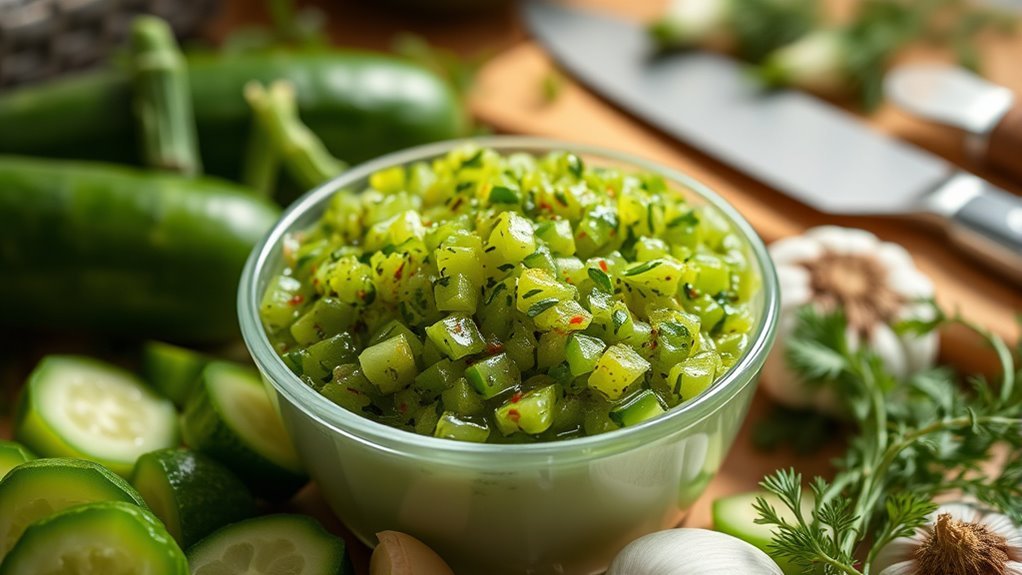Yes, relish can fit into a keto diet, but you need to choose wisely. Sweet relishes typically contain more carbs due to added sugars, while savory varieties like dill usually have fewer carbs, around 1-2 grams per tablespoon. Homemade relish is a great option, allowing you to control ingredients and keep carbs low. Always check labels for hidden sugars. If you’re interested in how to incorporate relish into your meals, there’s more to explore.
Understanding Relish and Its Ingredients

When it comes to understanding relish and its ingredients, it’s essential to recognize that not all relishes are created equal. Relish ingredients can vary widely, often including vegetables, fruits, and spices, which contribute to its distinct flavors. Common vegetables like cucumbers or peppers are often used, while fruits such as tomatoes or apples may appear in sweeter versions.
You’ll find various relish types, from tangy dill to sweet fruit-based varieties, each catering to different palates. Understanding these differences helps you make informed choices, especially if you’re considering how they fit into your dietary preferences. Always check ingredient labels, as added sugars or preservatives can affect healthfulness. Embracing the variety allows you to enjoy relish while aligning with your culinary freedom.
Types of Relish: Sweet vs. Savory

Relish can be categorized into two primary types: sweet and savory, each offering unique flavors and uses in various dishes. Sweet relish typically contains sugar, vinegar, and chopped vegetables like cucumbers and bell peppers, making it a popular addition to hot dogs and burgers. On the other hand, savory relish usually emphasizes herbs and spices, providing a more complex flavor profile that complements meats, cheeses, and charcuterie boards. You might find that sweet relish appeals to those who enjoy a touch of sweetness, while savory relish caters to those who prefer bold, rich flavors. Understanding these distinctions helps you choose the right relish to enhance your meals, giving you the freedom to explore diverse culinary experiences.
Carb Content in Different Relish Varieties

While the flavor profiles of sweet and savory relishes differ greatly, their carbohydrate content can also vary, which is vital to take into account for those following a keto diet. Sweet relish varieties often contain higher sugar levels, leading to elevated carb counts that can quickly consume your daily limit. For instance, a tablespoon of sweet relish typically has around 3-4 grams of carbs. On the other hand, savory relishes, like dill or onion relish, usually have lower carb counts, averaging 1-2 grams per tablespoon. When choosing a relish, it’s important to check labels and be mindful of those hidden carbs. By understanding the carb content in different relish varieties, you can make informed decisions that align with your keto lifestyle.
Homemade Relish: A Keto-Friendly Option
What if you could create a delicious relish that fits perfectly into your keto diet? Homemade relish offers you the freedom to choose your ingredients, ensuring you stick to low carb alternatives. By using fresh vegetables like cucumbers, bell peppers, and onions, you can whip up a tangy condiment without the added sugars found in store-bought options. Vinegar, mustard seeds, and spices can enhance flavors while keeping carbs in check. Plus, making your own relish allows you to control the texture and taste, tailoring it to your preferences. With just a few homemade ingredients, you can enjoy a flavorful addition to your meals, all while staying committed to a keto lifestyle. Embrace the freedom of customization!
How to Incorporate Relish Into Keto Meals
Incorporating relish into your keto meals can enhance flavor without adding carbs. You can choose low-carb relish options and explore various flavor pairings to complement your dishes. Additionally, creative serving ideas can make relish a versatile ingredient in your keto cooking.
Low-Carb Relish Options
If you’re following a keto diet, finding low-carb relish options can enhance your meals without disrupting your nutritional goals. Here are some tasty low carb alternatives that serve as great keto condiments:
- Sugar-Free Dill Relish: This classic option adds a zesty kick to your dishes without the carbs.
- Avocado Relish: Creamy and rich, this alternative not only fits the keto profile but also boosts your healthy fat intake.
- Spicy Pepper Relish: If you enjoy a little heat, this relish can elevate your meals while remaining low in carbs.
Incorporating these relishes into your meals can help you maintain flavor and variety, ensuring you stay on track with your keto journey. Enjoy the freedom of flavorful eating!
Flavor Pairing Suggestions
When you’re looking to enhance the flavor of your keto meals, using relish can be a game-changer. Relish brings unique flavor profiles that can elevate a variety of dishes. For instance, try pairing a tangy dill relish with grilled chicken for a zesty kick. If you’re enjoying a hearty burger wrapped in lettuce, a sweet and spicy relish can provide a delightful contrast to the savory meat. You can also mix relish into egg salads or tuna salads for an unexpected twist, creating vibrant taste combinations. Don’t forget to experiment with different relishes based on your meal; the right choice can transform your dish while keeping it low-carb and aligned with your keto lifestyle. Enjoy the freedom of flavor!
Creative Serving Ideas
While many think of relish as merely a condiment, it can be a versatile ingredient that enhances the appeal of your keto meals. Here are some creative serving ideas to inspire unique presentations:
- Stuffed Avocados: Fill avocado halves with chicken salad mixed with relish for a rejuvenating twist.
- Relish-Topped Cauliflower Rice: Use relish as a vibrant topping on sautéed cauliflower rice, adding flavor and crunch.
- Keto Sliders: Elevate your mini burgers by adding a dollop of relish; it complements the richness of the meat perfectly.
Incorporating relish into your dishes not only adds flavor but also encourages creative pairings that can make your keto journey exciting and satisfying. Enjoy experimenting with these ideas!
Popular Brands of Relish and Their Nutritional Information
When considering relish for your keto diet, it’s important to look at the common ingredients and their nutritional profiles. Popular brands often vary in sugar content and carbohydrates, which can impact your daily intake. Let’s compare a few options to help you make an informed choice.
Common Relish Ingredients
Relish, a popular condiment often used to enhance the flavor of various dishes, typically contains a few common ingredients that can vary by brand. Understanding these components can help you make informed choices, especially if you’re considering relish variations for your diet. Here are three key ingredients you might find:
- Cucumbers – The primary base for many relishes, providing crunch and hydration.
- Vinegar – Used for acidity and preservation, often flavored with pickling spices.
- Sugar – Adds sweetness, but the amount can differ greatly among brands.
Nutritional Comparison Chart
Understanding the common ingredients in relish sets the stage for evaluating its nutritional profile. Popular brands often vary in their flavor profiles and nutritional benefits. For instance, a standard sweet relish may contain around 50 calories and 12 grams of sugar per serving, while a dill relish typically has fewer calories at about 15, with minimal sugars.
A comparison chart reveals that low-sodium options can enhance flavor without the extra salt. When considering keto diets, look for relishes with lower sugar and higher fiber content. Brands like Whole Foods offer organic choices that align with healthier eating. Ultimately, knowing these nutritional details allows you to enjoy relish while making conscious choices that fit your dietary goals.
Tips for Choosing Keto-Friendly Condiments
How can you guarantee your condiments fit into a keto diet? Choosing the right keto condiments can enhance your meals without derailing your progress. Here are some tips to keep in mind:
- Check the Labels: Look for low carb sauces with minimal sugar and unhealthy fats. Aim for options with less than 1g of carbs per serving.
- Opt for Natural Ingredients: Choose condiments made from whole foods. Ingredients like olive oil, vinegar, and herbs are great for flavor without the carbs.
- Experiment with Homemade Versions: Making your own low carb sauces allows you to control ingredients and carb content, giving you freedom in your diet.
Frequently Asked Questions
Can I Eat Relish on a Ketogenic Diet?
Imagine your taste buds dancing like leaves in the wind; relish can be that zingy partner in your keto journey. However, not all relishes are created equal. You’ll want to check the relish ingredients for sugars and carbs. Opt for keto-friendly options with low sugar content, like dill or sugar-free varieties, to keep your diet on track while adding flavor. Enjoy the burst of taste without sacrificing your keto goals!
Is Sugar-Free Relish Available in Stores?
Yes, sugar-free relish is available in many stores, often found in the condiment aisle. These options typically use sugar substitutes, making them a great choice for those looking to cut down on sugar. If you’re exploring condiment alternatives, try brands that focus on low-carb and keto-friendly ingredients. Always check the label to verify it meets your dietary needs, and enjoy the freedom to add flavor without the extra carbs!
How Long Does Homemade Relish Last?
Homemade relish can last about 1 to 2 weeks in the fridge if stored properly. For ideal relish storage, keep it in an airtight container to prevent spoilage. If you want it to last longer, consider freezing it, which can extend its shelf life for several months. Remember, homemade condiment shelf life depends on ingredients used, so always check for signs of spoilage, like off smells or changes in texture before using.
Are There Vegan Relish Options?
If you’re exploring vegan relish options, you’ll be pleased to know there are plenty of delicious alternatives. For instance, consider a homemade relish made with chopped cucumbers, tomatoes, and onions, mixed with apple cider vinegar and herbs—it’s an invigorating choice! By using vegan ingredients, you can create a satisfying condiment that complements various dishes. Plus, experimenting with different veggies can lead to unique relish alternatives that cater to your taste buds and dietary needs.
Can Relish Be Frozen for Later Use?
Yes, you can freeze relish for later use! For effective relish storage, make certain to use airtight containers or freezer bags to prevent freezer burn. It’s best to leave a little space at the top of the container, as the relish will expand when frozen. When you’re ready to use it, just thaw it in the fridge overnight. Following these freezing tips guarantees your relish retains its flavor and texture for future enjoyment!


